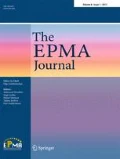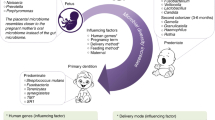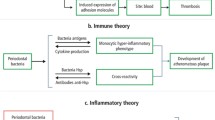Abstract
Three recent advances in immunology, genetics, and microbiology have ushered in a new era in the continued efforts to better understand and treat oral diseases, moving ever closer to the three Ps of modern healthcare: personalized, predictive, and preventive medicine (PPPM). The discovery of now 15 subtypes of innate lymphoid cells, the refinement of DNA sequencing, and culture-independent characterization of the entire microbial community begin to reveal this complex adaptive network. All these advances warrant a systematic review as they have changed and will continue to change dental medicine. We will update dental professionals on these advances as related to oral diseases and associated pathologies in other organ systems such as premature labor, arthrosclerosis, and cancer. The five objectives are:
-
1.
Introduce the concept of microbiota and microbiome
-
2.
Explain how we study microbiota and microbiome
-
3.
Describe the types and functions of innate lymphoid cells
-
4.
Inventory the unique demands of the oral cavity
-
5.
Provide a heuristic model to integrate the above
-
6.
Conclusions and expert recommendations


Similar content being viewed by others
References
Dewhirst FE, Chen T, Izard J, Paster BJ, Tanner AC, Yu WH, et al. The human oral microbiome. J Bacteriol. 2010;192(19):5002–17.
Brunski JB, Puleo DA, Nanci A. Biomaterials and biomechanics of oral and maxillofacial implants: current status and future developments. Int J Oral Maxillofac Implants. 2000;15(1):15–46.
Sharpton TJ. An introduction to the analysis of shotgun metagenomic data. Front Plant Sci. 2014;5:209.
Beckers HJ, Van der Hoeven JS. Growth rates of Actinomyces viscosus and Streptococcus mutans during early colonization of tooth surfaces in gnotobiotic rats. Infect Immun. 1982;35(2):583–7.
Yu JC, Khodadadi H, Malik A, Davidson B, Salles ÉD, Bhatia J, et al. Innate immunity of neonates and infants. Front Immunol. 2018;9.
Jiménez E, Fernández L, Marín ML, Martín R, Odriozola JM, Nueno-Palop C, et al. Isolation of commensal bacteria from umbilical cord blood of healthy neonates born by cesarean section. Curr Microbiol. 2005;51(4):270–4.
DiGiulio DB, Romero R, Kusanovic JP, Gómez R, Kim CJ, Seok KS, et al. Prevalence and diversity of microbes in the amniotic fluid, the fetal inflammatory response, and pregnancy outcome in women with preterm pre-labor rupture of membranes. Am J Reprod Immunol. 2010;64(1):38–57.
Fernández L, Langa S, Martín V, Maldonado A, Jiménez E, Martín R, et al. The human milk microbiota: origin and potential roles in health and disease. Pharmacol Res. 2013;69(1):1–0.
Dominguez-Bello MG, Costello EK, Contreras M, Magris M, Hidalgo G, Fierer N, et al. Delivery mode shapes the acquisition and structure of the initial microbiota across multiple body habitats in newborns. Proc Natl Acad Sci. 2010;107(26):11971–5.
Kolenbrander PE, Andersen RN, Blehert DS, Egland PG, Foster JS, Palmer RJ Jr., Communication among oral bacteria., Microbiol Mol Biol Rev. 2002;66(3):486–505
Simmerman E, Qin X, Marshall B, Perry L, Cai L, Wang T, et al. Innate lymphoid cells: a paradigm for low SSI in cleft lip repair. J Surg Res. 2016;205(2):312–7.
Aas JA, Paster BJ, Stokes LN, Olsen I, Dewhirst FE. Defining the normal bacterial flora of the oral cavity. J Clin Microbiol. 2005;43(11):5721–32.
Kikuchi M, Korioth TW, Hannam AG., The association among occlusal contacts, clenching effort, and bite force distribution in man., J Dent Res. 1997;76(6):1316–25
Marotte H, Farge P, Gaudin P, Alexandre C, Mougin B, Miossec P. The association between periodontal disease and joint destruction in rheumatoid arthritis extends the link between the HLA-DR shared epitope and severity of bone destruction. Ann Rheum Dis. 2006;65(7):905–9.
Palmer TM, Doak DF, Stanton ML, Bronstein JL, Kiers ET, Young TP, et al. Synergy of multiple partners, including freeloaders, increases host fitness in a multispecies mutualism. Proc Natl Acad Sci USA. 2010;107(40):17234–9.
Darveau RP. Periodontitis: a polymicrobial disruption of host homeostasis. Nat Rev Microbiol. 2010;8(7):481–90.
Rosen S. Hedonic prices and implicit markets: product differentiation in pure competition. J Polit Econ. 1974;82(1):34–55.
Graves DT, Cochran D. The contribution of interleukin-1 and tumor necrosis factor to periodontal tissue destruction. J Periodontol. 2003;74(3):391–401.
Bubnov RV, Babenko LP, Lazarenko LM, Mokrozub VV, Spivak MY. Specific properties of probiotic strains: relevance and benefits for the host. EPMA J. 2018;9(2):205–23.
Muegge BD, Kuczynski J, Knights D, Clemente JC, González A, Fontana L, et al. Diet drives convergence in gut microbiome functions across mammalian phylogeny and within humans. Science. 2011;332(6032):970–4.
Ugwumadu A, Manyonda I, Reid F, Hay P. Effect of early oral clindamycin on late miscarriage and preterm delivery in asymptomatic women with abnormal vaginal flora and bacterial vaginosis: a randomised controlled trial. Lancet. 2003;361(9362):983–8.
Heijtz RD. Fetal, neonatal, and infant microbiome: perturbations and subsequent effects on brain development and behavior. In seminars in fetal and neonatal medicine 2016 Dec 1 (Vol. 21, no. 6, pp. 410-417). WB Saunders.
Amare AT, Schubert KO, Baune BT. Pharmacogenomics in the treatment of mood disorders: strategies and opportunities for personalized psychiatry. EPMA J. 2017;8(3):211–27.
Baban B, Malik A, Bhatia J, Yu J. Presence and profile of innate lymphoid cells in human breast Milk. JAMA Pediatr. 2018;172(6):594–6.
Sampaio-Maia B, Monteiro-Silva F. Acquisition and maturation of oral microbiome throughout childhood: an update. Dental Res J. 2014;11(3):291–301.
Jorth P, Turner KH, Gumus P, Nizam N, Buduneli N, Whiteley M. Metatranscriptomics of the human oral microbiome during health and disease. MBio. 2014;5(2):e01012–4.
Maddi AB, Scannapieco FA. Oral biofilms, oral and periodontal infections, and systemic disease. Am J Dent. 2013;26(5):249–54.
Yazawa K, Araki K, Okazaki N, Watanabe K, Ishikawa C, Inoue A, et al. Production of eicosapentaenoic acid by marine bacteria. J Biochem. 1988;103(1):5–7.
Yu JC, Cai L, Wang TH, Berdel HO, Lee JH, Lam PS, et al. Tissue dynamics: lessons learned from sutural morphogenesis and cancer growth. Ann Plast Surg. 2016;77:S87–91.
Zarco MF, Vess TJ, Ginsburg GS. The oral microbiome in health and disease and the potential impact on personalized dental medicine. Oral Dis. 2012;18(2):109–20.
Farrell JJ, Zhang L, Zhou H, Chia D, Elashoff D, Akin D, et al. Variations of oral microbiota are associated with pancreatic diseases including pancreatic cancer. Gut. 2012;61(4):582–8.
Bubnov RV, Spivak MY, Lazarenko LM, Bomba A, Boyko NV. Probiotics and immunity: provisional role for personalized diets and disease prevention. EPMA J. 2015;6(1):14.
Golubnitschaja O, Costigliola V. Dental health: EPMA recommendations for innovative strategies. EPMA J. 2014;5,S1:A119
Ljungqvist O, Scott M, Fearon KC. Enhanced recovery after surgery: a review. JAMA Surg. 2017;152(3):292–8.
Author information
Authors and Affiliations
Contributions
JCY contributed to the scientific conception, preparations, writing, and editing. HK participated in preparations and writing. BB contributed to the scientific conception, preparations, writing and editing as well as participated in the sequence alignment.
Corresponding authors
Ethics declarations
Competing interests
The authors declare that they have no competing interests.
Consent for publication
Not applicable.
Ethical approval
This article is a mini-review and does not contain any studies with human or animal performed by any of the authors.
Additional information
Publisher’s note
Springer Nature remains neutral with regard to jurisdictional claims in published maps and institutional affiliations.
Rights and permissions
About this article
Cite this article
Yu, J.C., Khodadadi, H. & Baban, B. Innate immunity and oral microbiome: a personalized, predictive, and preventive approach to the management of oral diseases. EPMA Journal 10, 43–50 (2019). https://doi.org/10.1007/s13167-019-00163-4
Received:
Accepted:
Published:
Issue Date:
DOI: https://doi.org/10.1007/s13167-019-00163-4




